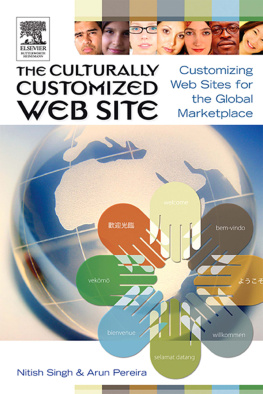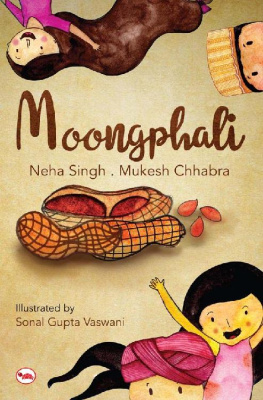Singh - The Culturally Customized Web Site
Here you can read online Singh - The Culturally Customized Web Site full text of the book (entire story) in english for free. Download pdf and epub, get meaning, cover and reviews about this ebook. publisher: Taylor & Francis (CAM), genre: Business. Description of the work, (preface) as well as reviews are available. Best literature library LitArk.com created for fans of good reading and offers a wide selection of genres:
Romance novel
Science fiction
Adventure
Detective
Science
History
Home and family
Prose
Art
Politics
Computer
Non-fiction
Religion
Business
Children
Humor
Choose a favorite category and find really read worthwhile books. Enjoy immersion in the world of imagination, feel the emotions of the characters or learn something new for yourself, make an fascinating discovery.
The Culturally Customized Web Site: summary, description and annotation
We offer to read an annotation, description, summary or preface (depends on what the author of the book "The Culturally Customized Web Site" wrote himself). If you haven't found the necessary information about the book — write in the comments, we will try to find it.
Singh: author's other books
Who wrote The Culturally Customized Web Site? Find out the surname, the name of the author of the book and a list of all author's works by series.
The Culturally Customized Web Site — read online for free the complete book (whole text) full work
Below is the text of the book, divided by pages. System saving the place of the last page read, allows you to conveniently read the book "The Culturally Customized Web Site" online for free, without having to search again every time where you left off. Put a bookmark, and you can go to the page where you finished reading at any time.
Font size:
Interval:
Bookmark:

THE CULTURALLY
CUSTOMIZED WEB SITE
Customizing Web Sites for the
Global Marketplace
THE CULTURALLY
CUSTOMIZED
WEB SITE
Customizing Web Sites for the
Global Marketplace
 | Nitish Singh, Ph.D. |
Elsevier Butterworth-Heinemann
30 Corporate Drive, Suite 400, Burlington, MA 01803, USA
Linacre House, Jordan Hill, Oxford OX2 8DP, UK
Copyright 2005, Elsevier Inc. All rights reserved.
No part of this publication may be reproduced, stored in a retrieval system, or transmitted in any form or by any means, electronic, mechanical, photocopying, recording, or otherwise, without the prior written permission of the publisher.
Permissions may be sought directly from Elsevier's Science & Technology Rights Department in Oxford, UK: phone: (+44) 1865 843830, fax: (+44) 1865 853333, e-mail: ), by selecting Customer Support and then Obtaining Permissions.
 Recognizing the importance of preserving what has been written, Elsevier prints its books on acid-free paper whenever possible.
Recognizing the importance of preserving what has been written, Elsevier prints its books on acid-free paper whenever possible.
Library of Congress Cataloging-in-Publication Data
On file at Library of Congress
British Library Cataloguing-in-Publication Data
A catalogue record for this book is available from the British Library.
ISBN: 0-7506-7849-6
For information on all Elsevier Butterworth-Heinemann publications visit our Web site at www.books.elsevier.com
05 06 07 08 09 10 10 9 8 7 6 5 4 3 2 1
Printed in the United States of America

For adoptive families the world over, in appreciation;
for Kavita and Meera, with love.
-AP
CONTENTS
PREFACE
This book is the result of over four years of research on various aspects of e-commerce, culture, and online consumer behavior. The Internet, with its unparalleled access to global customers and the potential for highly-customized marketing, has brought with it both promise and peril for international marketers. The promise of being born global with access to far-flung customers at unprecedented low costs must be tempered with the need for extraordinary business savvy to effectively confront the complexity of international competition and pressure on profit margins. How a global marketer manages the access to a vast, multicultural customer base, and handles other competitors vying for these customers will determine if it succeeds in the marketplace.
A key issue in the quest for global success through the Internet is the ability to design a web site that draws targeted customers, generates the desired behavior (be it a purchase or otherwise), builds trust and loyalty with these customers, and is invulnerable to competitive marketing actions. The process for this will obviously vary, depending on the needs of the targeted customersand customers in the global marketplace are of every cultural stripe possible, making for a multicultural sea of differing tastes and needs. In this context, where does one start to design web sites that are customized to draw specific cultural segments? The answer: right here, in this book.
Our researchalong with the research of othershas emphatically shown that culturally-adapted web content enhances usability, accessibility, and web site interactivity, with the relevant cultural group. To help implement such cultural adaptation, we provide a theoretically-sound, rigorously-tested framework. This framework provides the fundamental steps needed to culturally customize web sites. Our approach is country-based; as such we assume that countries can be defined by their dominant culture. The key reason for such an approach is a practical one: At present, global businesses continue to use countries as a basis for segmenting and targeting global customers (e.g., companies talk in terms of entering the Chinese market). However, we recognize that the continuing march of globalization is dramatically changing the world with massive migrations of people, and national borders being redefined or erased. In this context, targeting countries must be done with caution; a country may have strong subcultures established by immigrants (for example, Indians in UK, French in Canada, etc.). However, it must be noted that the resulting situationalthough more complexis still structurally unchanged (targeting Canada may mean a secondary target of the French in Canada; thus both are again, country based). As such, our approach of defining countries based on their dominant culture(s) is practical, and readily implemented by companies looking for success in the global marketplace.
In conclusion, we would like to acknowledge the help and inspiration we received from faculty members and students at California State University and Saint Louis University. Our special thanks to California State University Research Foundation for the grant that they made available to write this book. Finally, we also extend our thanks to several academic reviewers and consultants that provided us valuable feedback and recommendations.
All examples of web sites used in the book were accessed from the Web during 2004. Please visit www.theculturallycustomizedwebsite.com for additional information and updates.
Nitish Singh
California State University, Chico
Arun Pereira
Saint Louis University
FOREWORD
The phenomenal growth of the Internetand its associated World Wide Webis a development that's not expected to abate in the near future. The World Wide Web removes all national boundaries in global commerce. With the expansion of market boundaries comes a broadening of the diversity within the pool of prospective customers. Thus, sales toolssuch as web sitesmust be treated with sensitivity to the demographic profiles of the various targets around the world. Companies that realize the importance of cultural differences, and design web materials with this in mind, will increase international market shareat the expense of those who ignore local customs. This book will help companies avoid unintended mistakes and cultural misunderstandings.
The Culturally Customized Web Site, by Professors Nitish Singh and Arun Pereira, is a timely publication that provides valuable information and insight into designing web sites for worldwide e-commerce. This book is the first comprehensive how to publication for customizing web sites to specific country cultures. The guidelines offered, which are specific and clearly written, are based on sound theory and vigorous empirical testing. Furthermore, this book is well organized, so that readers will easily understand the cultural differences underlying the global market.
Companies and institutions targeting culturally diverse customers can use this book to gain knowledge of the specific attributes required in a web site to attract a particular target groupincreasing the probability of repeat visits and the building of customer trust and loyalty. For example, if a company wants to target customers in Australia, France, India, and China, the web sites will have to be different; reflecting core cultural differences which impact business practices and human behavior.
This book is appropriate for several audiences: First, web designers who design web sites for international companies and organizations will find that this book complements their technical expertise by offering insights into cultural diversity and its implications for web design. Second, managers of multinational companies and other organizations who target multicultural groups across the globe will find that this book provides a framework that will help them understand the breadth and depth of resources needed to be allocated in order to fund the cultural customization of their web materials. Finally, faculty who teach courses such as International Marketing, Global E-Commerce, International Advertising and other international business courses will find that this book provides an outline to teach students the cultural aspects of online marketing, based on established theory and empirical testing, along with end of chapter exercises that enhance the classroom learning experience.
Font size:
Interval:
Bookmark:
Similar books «The Culturally Customized Web Site»
Look at similar books to The Culturally Customized Web Site. We have selected literature similar in name and meaning in the hope of providing readers with more options to find new, interesting, not yet read works.
Discussion, reviews of the book The Culturally Customized Web Site and just readers' own opinions. Leave your comments, write what you think about the work, its meaning or the main characters. Specify what exactly you liked and what you didn't like, and why you think so.



















